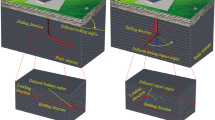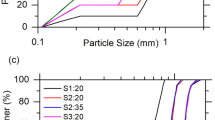Abstract
Internal erosion under seepage flow affects the hydraulic and mechanical behavior of the soil, which is one of the most important factors of geological disasters. Due to that the soil–rock interface can be the potential preferential seepage channels commonly, the characteristics of erosion are more significant and hazardous at the soil–rock interface. In this study, a series of laboratory experiments are performed to investigate the failure mechanism and evolution of interfacial seepage erosion. The influences of two essential influence factors (i.e., the confining pressure and the roughness of the interface) are investigated by comparing the seepage velocity, hydraulic conductivity, failure hydraulic gradient, and failure hydraulic shear stress in experiments. Furthermore, the failure pattern of interfacial seepage erosion is particular investigated by the CT scanning. The interfacial seepage erosion tests indicate that the interfacial seepage erosion shows a three-phase progressive failure as the hydraulic gradient increases and the hydraulic conductivity decrease with the progress of suffusion in the initiation phase. The increase of confining pressure leads to the increase of failure hydraulic gradient. The results of CT scanning show that the roughness of the soil–rock interface significantly affects the size and shape of resulting zone of erosion.





















Similar content being viewed by others
Data availability
Some or all data, models, or code that support the findings of this study are available from the corresponding author upon reasonable request.
References
Amiri-Tokaldany, Ebrahim, Darby, Stephen E, Tosswell, Paul (2003) Bank stability analysis for predicting reach scale land loss and sediment yield. J Am Water Resour Assoc 39(4):897–909
Baik MH, Cho WJ, Hahn PS (2007) Erosion of bentonite particles at the interface of a compacted bentonite and a fractured granite. Eng Geol 91:229–239
Barton N, Choubey V (1977) The shear strength of rock joints in theory and practice. Rock Mechanics Felsmechanik Mcanique des Roches 10 (1-2):1–54
Barton AP et al (2004) Effects of soil conservation measures on erosion rates and crop productivity on subtropical Ultisols in Yunnan Province, China. Agric Ecosyst Environ 104:343–357
Beguin R, Philippe P, Faure YH (2013) Pore-scale flow measurements at the interface between a sandy layer and a model porous medium: application to statistical modeling of contact erosion. J Hydraul Eng 139:1–11
Bendahmane F, Marot D, Alexis A (2008) Experimental parametric study of suffusion and backward erosion. J Geotech Geoenviron 134:57–67
Bonelli S (2012) Erosion of Geomaterials. In: Donaghe RT, Chaney RC, Silver ML (Ed.), Advanced Triaxial Testing of Soils and Rock, ASTM STP 977. American Society for Testing and Materials, Philadelphia, 387–404
Boon CW, Houlsby GT, Utili S (2014) New insights into the 1963 Vajont slide using 2D and 3D distinct-element method analyses. Geotechnique 64:800–816
Chaney RC, Demars KR, Reddi LN, Lee IM, Bonala MVS (2000) Comparison of internal and surface erosion using flow pump tests on a sand-kaolinite mixture. Geotech Test J 23
Chang DS, Zhang LM (2013) Critical hydraulic gradients of internal erosion under complex stress states. J Geotech Geoenviron 139:1454–1467
Chu-Agor ML, Fox GA, Cancienne RM, Wilson GV (2008) Seepage caused tension failures and erosion undercutting of hillslopes. J Hydrol 359:247–259
Costa JE, Schuster RL (1991) Documented historical landslide dams from around the world. Open File Report
Crosta G, Prisco CD (1999) On slope instability induced by seepage erosion. Can Geotech J 36:1056–1073
Crosta GB, Imposimato S, Roddeman D (2015) Landslide spreading, impulse water waves and modelling of the Vajont Rockslide. Rock Mech Rock Eng:1–24
Evans J (1988) Triaxial Permeability and Strength Testing of Contaminated Soils
Fell R, Fry JJ (2007) Internal erosion of dams and their foundations. CRC Press
Fell R, Wan CF, Cyganiewicz J, Foster M (2003) Time for development of internal erosion and piping in embankment dams. J Geotech Geoenviron 129:307–314
Flores-Berrones R, Ramirez-Reynaga M, Macari J (2011) Internal erosion and rehabilitation of an earth-rock dam. J Geotech Geoenviron 137:150–160
Fox GA, Wilson GV (2010) The role of subsurface flow in hillslope and stream bank erosion: a review. Soil Sci Soc Am J 74:717–733
Frost JD, Park JY (2003) A critical assessment of the moist tamping technique. Geotech Test J 26(1):57–70
Gao FP, Luo CC (2010) Flow-pipe-seepage coupling analysis of spanning initiation of a partially-embedded pipeline. J Hydrodyn 22:478–487
Grindrod P, Peletier M, Takase H (1999) Mechanical interaction between swelling compacted clay and fractured rock, and the leaching of clay colloids. Eng Geol 54:159–165
Haghighi I, Chevalier C, Duc M, Guedon S, Reiffsteck P (2013) Improvement of hole erosion test and results on reference soils. J Geotech Geoenviron 139:330–339
Huang D, Gu DM (2017) Influence of filling-drawdown cycles of the Three Gorges reservoir on deformation and failure behaviors of anaclinal rock slopes in the Wu Gorge. Geomorphology 295:489–506
Huang D, Gu DM, Song YX, Cen DF, Zeng B (2018) Towards a complete understanding of the triggering mechanism of a large reactivated landslide in the Three Gorges Reservoir. Eng Geol 238:36–51
Huang RQ (2009) Some catastrophic landslides since the twentieth century in the southwest of China. Landslides 6:69–81
Jiao Y-Y, Zhang H-Q, Tang H-M, Zhang X-L, Adoko Amoussou Coffi, Tian Hu-Nan (2014) Simulating the process of reservoir-impoundment-induced landslide using the extended DDA method. Eng Geol 182:37–48
Karmaker T, Dutta S (2013) Modeling seepage erosion and bank retreat in a composite river bank. J Hydrol 476:178–187
Ke L, Takahashi A (2014) Experimental investigations on suffusion characteristics and its mechanical consequences on saturated cohesionless soil. Soils Found 54:713–730
Kilburn CRJ, Petley DN (2003) Forecasting giant, catastrophic slope collapse: Lessons from Vajont, Northern Italy. Geomorphology 54(1-2):21–32
Kim HJ, Park JM, Shin JH (2019) Flow behaviour and piping potential at the soil–structure interface. Géotechnique 69:79–84
Korup O (2004) Geomorphometric characteristics of New Zealand landslide dams. Eng Geol 73:13–35
Lambe TW, Whitman RV (1969) Soil mechanics. Series in Soil Engineering
Lin F, Zhou CG, Gao XJ (2003) Study on anti-seepage treatment of Bayi reservoir dam. Chin J Rock Mech Eng 22(S2):2925–2928 (in Chinese)
Lin H (2012) How to treat the geological hazards in Three Gorges Reservoir—interview with Chen Deji. http://www.mlr.gov.cn/xwdt/dzhj/201204/t20120428_1091759.html
Locke M, Indraratna B, Adikari G (2001) Time-dependent particle transport through granular filters. J Geotech Geoenviron Eng 127:521–529
Luo SL, Jin XG, Huang D (2019) Long-term coupled effects of hydrological factors on kinematic responses of a reactivated landslide in the Three Gorges Reservoir. Eng Geol:261
Luo YL, Wu Q, Zhan ML, Sheng JC (2012) Study of critical piping hydraulic gradient of suspended cut-off wall and sand gravel foundation under different stress states. Rock Soil Mech 33:73–78
Mao CX, Duan XB, Cai JB, Ru JH (2005) Experimental study on piping development control by means of suspended cut-off wall. J Hydraul Eng 36(1):42–50 (in Chinese)
Massey CI, Petley DN, McSaveney MJ (2013) Patterns of movement in reactivated landslides. Eng Geol 159:1–19
Moffat R, Fannin RJ (2011a) A hydromechanical relation governing internal stability of cohesionless soil. Can Geotech J 48:413–424
Moffat R, Fannin RJ, Garner SJ (2011b) Spatial and temporal progression of internal erosion in cohesionless soil. Can Geotech J 48:399–412
Nakamura K (1990) On reservoir landslide. Bull. Soil Water Conserv 10(1):53–64 (in Chinese)
Pan P, Shang Y-q, Lü Q, Yu Y (2017) Periodic recurrence and scale-expansion mechanism of loess landslides caused by groundwater seepage and erosion. Bull Eng Geol Environ 78:1143–1155
Paronuzzi P, Rigo E, Bolla A (2013) Influence of filling–drawdown cycles of the Vajont reservoir on Mt. Toc slope stability. Geomorphology 191:75–93
Premkumar S, Piratheepan J, Arulrajah A, Disfani MM, Rajeev P (2016) Experimental study on contact erosion failure in pavement embankment with dispersive clay. J Mater Civ Eng 28:04015179
Richards KS, Reddy KR (2007) Critical appraisal of piping phenomena in earth dams. Bull Eng Geol Environ 66:381–402
Richards KS, Reddy KR (2012) Experimental investigation of initiation of backward erosion piping in soils. Geotechnique 62:933–942
Sato M, Kuwano R (2015) Suffusion and clogging by one-dimensional seepage tests on cohesive soil. Soils Found 55:1427–1440
Sellmeijer H, de la Cruz JL, van Beek VM, Knoeff H (2011) Fine-tuning of the backward erosion piping model through small-scale, medium-scale and IJkdijk experiments. Eur J Environ Civ Eng 15:1139–1154
Suits LD, Sheahan TC, Chang DS, Zhang LM (2011) A stress-controlled erosion apparatus for studying internal erosion in soils. Geotech Test J:34
Vakili AH, Shojaei SI, Salimi M, Bin Selamat MR, Farhadi MS (2020) Contact erosional behaviour of foundation of pavement embankment constructed with nanosilica-treated dispersive soils. Soils Found 60:167–178
Wan CF, Fell R (2004) Investigation of rate of erosion of soils in embankment dams. J Geotech Geoenviron 130:373–380
Wang HB, Xu WY, Xu RC, Jiang QH, Liu JH (2007) Hazard assessment by 3D stability analysis of landslides due to reservoir impounding. Landslides 4:381–388
Wörman A, Olafsdottir R (2010) Erosion in a granular medium interface. J Hydrol Res 30:639–655
Xie QY, Liu J, Han B, Li HT, Li YY, Jiang ZQ (2019) Experimental investigation of interfacial erosion on culvert-soil interface in earth dams. Soils Found 59:671–686
Yin Y, Huang B, Wang W, Wei Y, Ma X, Ma F, Zhao C (2016) Reservoir-induced landslides and risk control in Three Gorges Project on Yangtze River, China. J Rock Mech Geotech Eng 8(5):577–595
Notation
The following symbols are used in this paper:
CTnumber CT number of scanning material (Hu)
i hydraulic gradient
K intrinsic permeability
k hydraulic conductivity (m/s)
n soil porosity
v Darcy velocity (m/s)
μ absorption coefficient of scanning material
η dynamic viscosity (kg/m ∙ s)
τ hydraulic shear stress (Pa)
Funding
The research was supported by the National Natural Science Foundation of China (Nos. 41972297 and 41902290) and by supporting program of hundred promising innovative talents in Hebei Provincial Education Office (No. SLRC2019027) and by Natural Science Foundation of Hebei Province (No. D2020202002).
Author information
Authors and Affiliations
Corresponding author
Ethics declarations
Competing interests
Not applicable
Code availability
Not applicable
Rights and permissions
About this article
Cite this article
Huang, D., Huang, WB., Ke, CY. et al. Experimental investigation on seepage erosion of the soil–rock interface. Bull Eng Geol Environ 80, 3115–3137 (2021). https://doi.org/10.1007/s10064-021-02104-w
Received:
Accepted:
Published:
Issue Date:
DOI: https://doi.org/10.1007/s10064-021-02104-w




